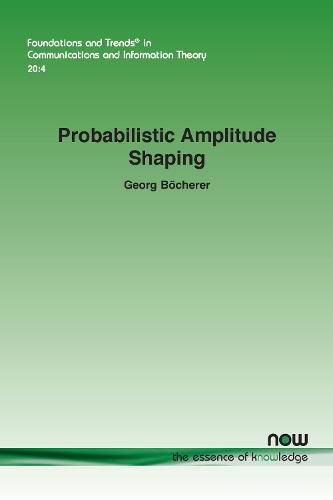Readings Newsletter
Become a Readings Member to make your shopping experience even easier.
Sign in or sign up for free!
You’re not far away from qualifying for FREE standard shipping within Australia
You’ve qualified for FREE standard shipping within Australia
The cart is loading…






This title is printed to order. This book may have been self-published. If so, we cannot guarantee the quality of the content. In the main most books will have gone through the editing process however some may not. We therefore suggest that you be aware of this before ordering this book. If in doubt check either the author or publisher’s details as we are unable to accept any returns unless they are faulty. Please contact us if you have any questions.
Probabilistic amplitude shaping (PAS) is a practical architecture for combining non-uniform distributions on higher-order constellations with off-the-shelf forward error correction (FEC) codes. This efficient and practical technique has had a large industrial impact, in particular in fiber-optic communications. This monograph details the practical considerations that led to the invention of PAS and provides an information-theoretic assessment of the PAS architecture. Because of the separation into a shaping layer and an FEC layer, the theoretic analysis of PAS requires new tools. On the shaping layer, the cost penalty and rate loss of finite length DMs is analyzed. On the FEC layer, achievable FEC rates are derived. Using mismatched decoding, achievable rates are studied for several decoding metrics of practical importance. Combining the findings, it is shown that PAS with linear codes is capacity-achieving on a certain class of discrete input channels.
Written by one of the inventors of Probabilistic Amplitude Shaping, this monograph contains a wealth of insights into the theory and practical implementation of the technique in modern communication systems. This is a must read for engineers and students of communications.
$9.00 standard shipping within Australia
FREE standard shipping within Australia for orders over $100.00
Express & International shipping calculated at checkout
This title is printed to order. This book may have been self-published. If so, we cannot guarantee the quality of the content. In the main most books will have gone through the editing process however some may not. We therefore suggest that you be aware of this before ordering this book. If in doubt check either the author or publisher’s details as we are unable to accept any returns unless they are faulty. Please contact us if you have any questions.
Probabilistic amplitude shaping (PAS) is a practical architecture for combining non-uniform distributions on higher-order constellations with off-the-shelf forward error correction (FEC) codes. This efficient and practical technique has had a large industrial impact, in particular in fiber-optic communications. This monograph details the practical considerations that led to the invention of PAS and provides an information-theoretic assessment of the PAS architecture. Because of the separation into a shaping layer and an FEC layer, the theoretic analysis of PAS requires new tools. On the shaping layer, the cost penalty and rate loss of finite length DMs is analyzed. On the FEC layer, achievable FEC rates are derived. Using mismatched decoding, achievable rates are studied for several decoding metrics of practical importance. Combining the findings, it is shown that PAS with linear codes is capacity-achieving on a certain class of discrete input channels.
Written by one of the inventors of Probabilistic Amplitude Shaping, this monograph contains a wealth of insights into the theory and practical implementation of the technique in modern communication systems. This is a must read for engineers and students of communications.